The Grey Wolf (Canis lupus) and the German Shepherd (Canis lupus familiaris) are closely related species, yet remarkably different in behavior, physical traits, and their roles alongside humans.
This comparison delves into their origins, anatomy, intelligence, instincts, strength, and interactions with humans to highlight their evolutionary paths and functional distinctions.
| Canis lupus is the scientific name for the Grey Wolf, the largest wild member of the dog family. It is the ancestor of all domestic dogs. |
Topics
- Origins and Evolution
- Physical Characteristics
- German Shepherd vs Grey Wolf: Who Would Win?
- Behavior and Temperament
- Intelligence and Trainability
- Human Interaction
- Hybrid Warning: The Wolf-Dog Dilemma
- Conclusion
|| DON’T MISS! Today’s Deals on Chewy – Pet Foods, Products, Supplies, Toys, and more. Additionally, visit our Etsy & Online Store for German Shepherd merchandise.
01. Origins and Evolution
Grey Wolf
The Grey Wolf is the largest and most widespread wild member of the Canidae family. Native to North America, Eurasia, and parts of the Middle East, wolves have existed for over 300,000 years. They are apex predators and keystone species, shaping ecosystems through their hunting patterns.
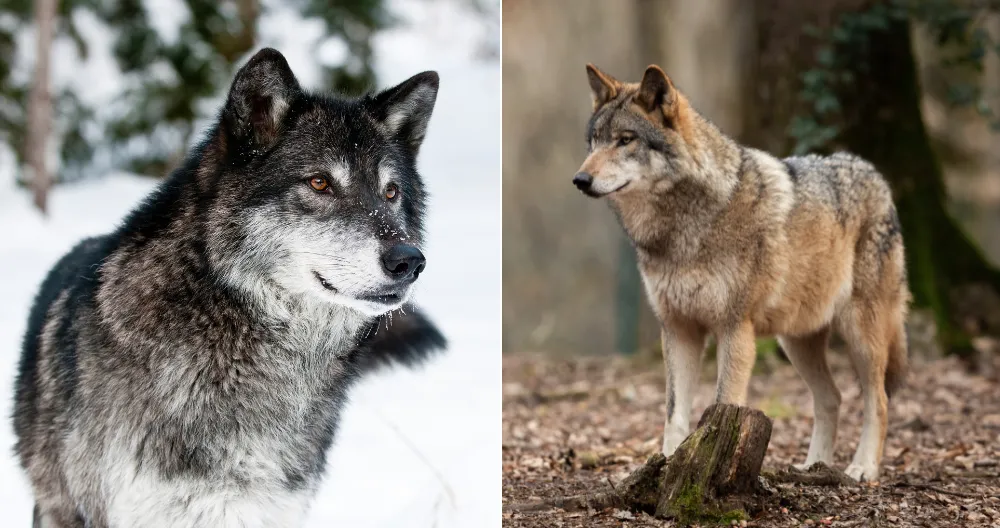
There are several subspecies of Grey Wolf, each adapted to different regions and climates. Common types include:
- Arctic Wolf (Canis lupus arctos) – found in the Arctic tundra
- Timber Wolf (Canis lupus lycaon) – native to eastern North America
- Mackenzie Valley Wolf (Canis lupus occidentalis) – one of the largest, from Alaska and western Canada
- Eurasian Wolf (Canis lupus lupus) – widespread across Europe and Asia
- Mexican Wolf (Canis lupus baileyi) – the smallest and most endangered, native to the southwestern U.S. and Mexico
Each differs in size, color, and behavior based on habitat.
German Shepherd
German Shepherds are domestic dogs bred in Germany in the late 19th century by Captain Max von Stephanitz. Intended to be highly intelligent and obedient working dogs, they descend directly from herding dogs, which, in turn, share ancestry with the Grey Wolf.
RELATED
- Are German Shepherds Descendants of Wolves?
- In What Ways German Shepherds Are Similar to Wolves?
- How Does Selective Breeding Affect Dog’s Appearance
Despite genetic proximity, thousands of years of selective breeding have created major behavioral and physical differences.

There are 5 main types of German Shepherds, which are classified in two main categories, i.e., Showline and Workingline.
- American Showline German Shepherds
- West/European Showline German Shepherds
- West Working Line German Shepherds
- East Working Line DDR German Shepherds
- Czech Working Line German Shepherds
RELATED
- 5 Different Types Of German Shepherd Breed & Their Features
- How Slant (Sloped) Back German Shepherds Were Created?
02. Physical Characteristics
Grey wolves are generally larger and more robust, built for endurance and survival in harsh wild environments. German Shepherds are more agile and trainable, with physical traits tailored for utility and service.
| Feature | Grey Wolf | German Shepherd |
|---|---|---|
| Height (at shoulder) | 26–32 inches | 22–26 inches |
| Weight | 65–120 lbs | 50–90 lbs |
| Coat | Dense, double-layered, grey/white/brown/black | Medium-length double coat, variety of colors, black and tan most common. |
| Skull | Broad, powerful jaws | Narrower snout and skull |
| Tail | Long and bushy, carried low | Bushy, carried slightly curved |
| Bite Force | 400 –1,200 PSI | ~238 – 300 PSI |
NOTE: There are breeders such as Ayers Legends in Oklahoma, who breed old-fashioned German Shepherds with impressively large frames, broad chests, straight backs, weighing up to an astounding 150 pounds, and tall up to 31 inches at the shoulder, making them as large as grey wolves.

RELATED
- 4 Types of German Shepherd Coats
- German Shepherd Coat Color Patterns and Variations
- German Shepherd Energy Levels by Age | Activity Needs
2.1 German Shepherd vs Grey Wolf: Who Would Win a One-on-One Fight Between a Grey Wolf & German Shepherd?
Even a working-line German Shepherd—while more powerful, brave, driven, and muscular than standard Shepherds would likely lose to a Grey Wolf in a one-on-one fight. Below are the reasons:
- Elite GSDs max out around 300 PSI, while grey wolves can exceed 1,000 PSI.
- Wolves regularly fight to kill for survival. GSDs, no matter how trained, are not conditioned for kill-or-be-killed combat.
- Wolves have broader skulls and larger canines, built for crushing bone, something Shepherds aren’t anatomically designed to do.
- Wolves can travel 30+ miles a day and hunt large prey — they are relentless.

03. Behavior and Temperament
Grey Wolf
- Wild Instincts: Grey wolves are highly territorial, social animals that rely on complex pack dynamics.
- Hunting & Survival: They travel vast distances in coordinated packs to hunt elk, deer, and other prey.
- Fear of Humans: They naturally avoid human contact and are difficult to domesticate.
- Communication: Use howls, body language, and scent marking to coordinate within the pack.

German Shepherd
- Trainable: Bred specifically for obedience, loyalty, and intelligence.
- Protective Nature: Excellent guard dogs; naturally wary of strangers but loyal to family.
- Work-Oriented: Thrive in police, military, rescue, and service roles.
- Socialization: Easily socialized with humans and other animals when trained early.

RELATED
- How Do German Shepherds Handle Hot Weather
- German Shepherd Running Abilities: Speed, Distance, Endurance
- Understanding the Prey Drive of German Shepherds
04. Intelligence and Trainability
Grey Wolves possess raw intelligence suited for survival, strategic hunting, and adapting to wild environments. However, they are independent and unmotivated by human rewards, making them very difficult to train.
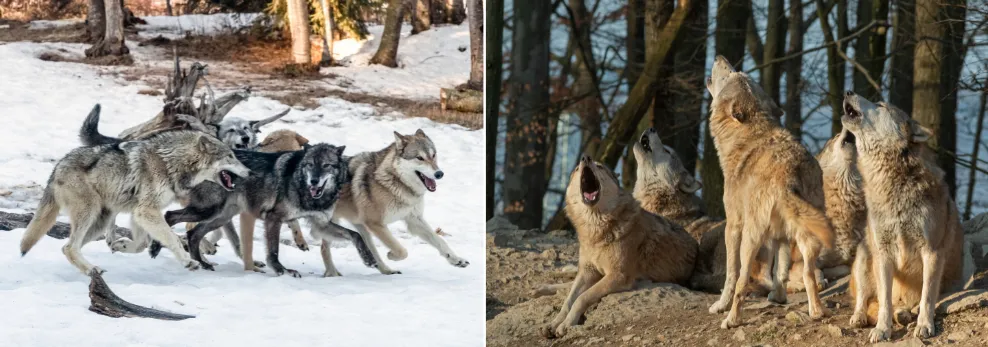
German Shepherds rank among the most intelligent dog breeds. They respond to voice commands, gesture cues, and are highly motivated by praise or treats. Their mental flexibility allows them to learn hundreds of commands and behaviors.
RELATED
- Training German Shepherds for Families With Young Children
- Role of German Shepherds in Therapy & Emotional Support
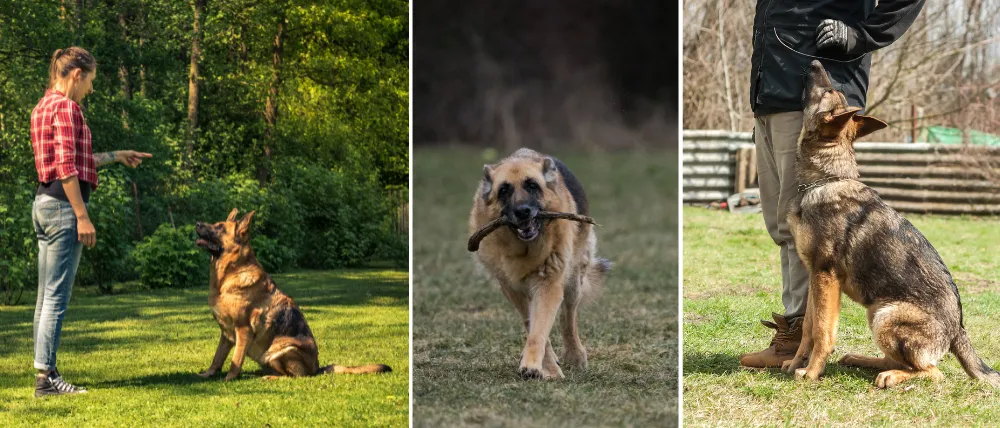
05. Human Interaction
While wolves remain important in the wild for ecological balance, they are not suitable pets. In contrast, the German Shepherd was bred specifically to work with humans, making it a loyal and intelligent family member or professional partner.
| Aspect | Grey Wolf | German Shepherd |
|---|---|---|
| Domestication | Wild animal | Fully domesticated |
| Ownership Legality | Illegal or restricted in many places | Widely accepted as pets |
| Training | Nearly impossible for most people | Highly trainable |
| Role | Ecological predator | Companion, service, military, police, therapy |
06. Hybrid Warning: The Wolf-Dog Dilemma
Some individuals attempt to breed wolf-dog hybrids, a dangerous and unpredictable mix. These hybrids often inherit the wild instincts of wolves and the social confusion of domesticity, leading to behavioral issues, fearfulness, or aggression. Most veterinarians and behaviorists advise against owning hybrids due to legal, ethical, and safety concerns.
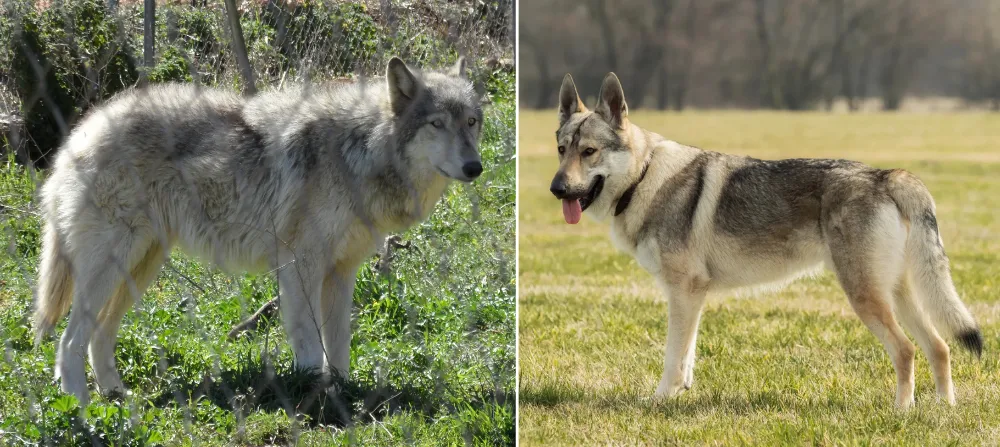
Conclusion
The Grey Wolf and the German Shepherd represent two ends of the canine evolutionary spectrum—one wild and untamed, the other a loyal and disciplined domestic companion. While they share a common ancestor, thousands of years of adaptation and selective breeding have created two remarkably different animals.
For those fascinated by wolves, observing them in the wild or through conservation efforts is the safest and most ethical way to appreciate their power and mystery. For those seeking companionship, intelligence, and reliability, the German Shepherd stands as one of the most versatile and devoted dogs in the world.
Enjoyed this post? Share it with your friends to spread the word! We’d love to hear your thoughts—drop your feedback in the comments below!

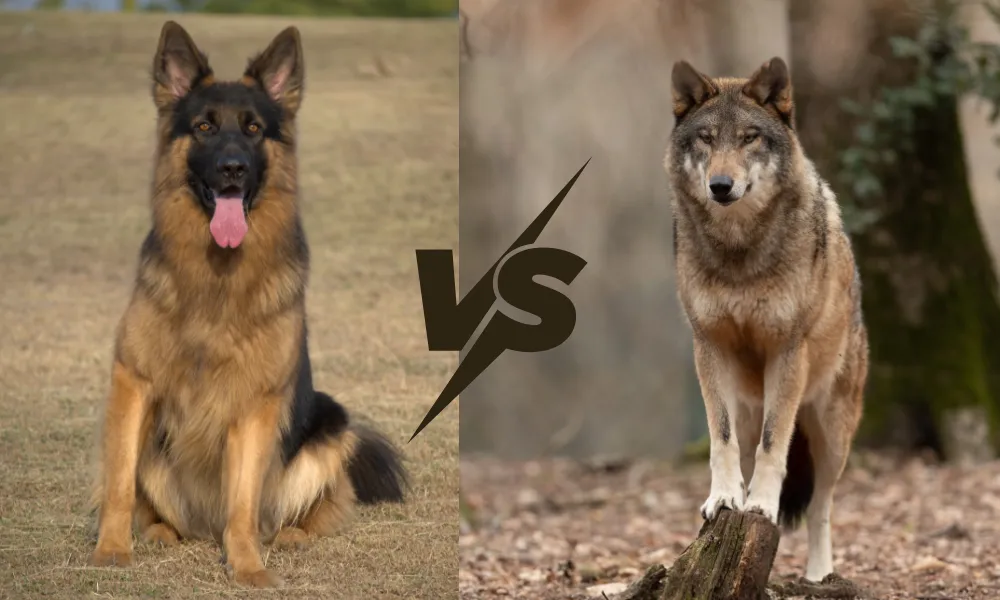
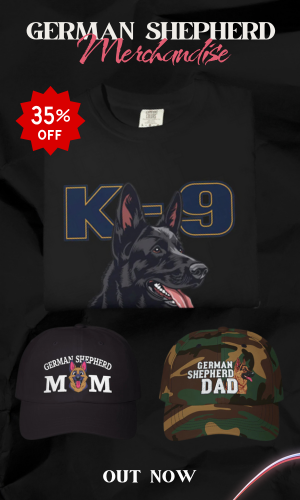

Leave a Reply